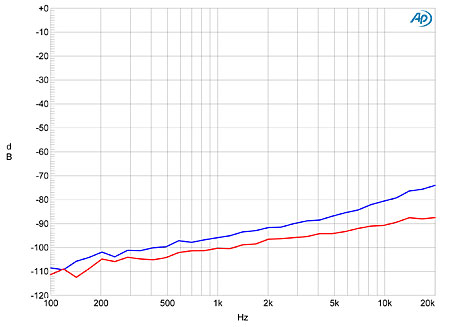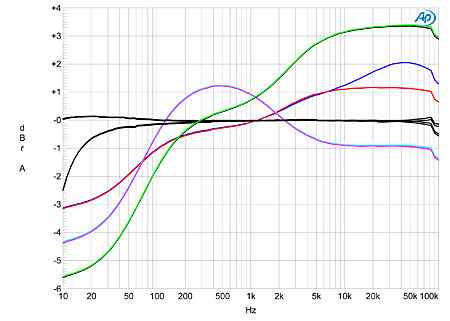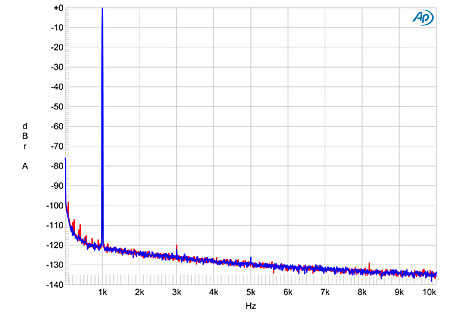| Columns Retired Columns & Blogs |
Boulder Amplifiers 1008 phono preamplifier Measurements
Sidebar 2 Measurements
I measured the Boulder 1008 with Stereophile's loan sample of the Audio Precision SYS2722 system (see the January 2008 "As We See It" and www.ap.com). The voltage gain was sensibly arranged, at 38.4dB for moving-magnet cartridges and 64dB for moving-coils. These figures include the interaction between the signal generator's source impedance and the Boulder's input impedance. Adjusted for that effect, the gains are 42.5dB and 68.5dB, respectively.
Both inputs preserved absolute polarity (ie, were non-inverting), and, with the supplied loading resistor in place in each input module, offered low input impedances of 74 ohms (MC) and 80 ohms (MM). Though both figures were consistent across the audioband, the latter, of course, is much lower than is required for proper operation; Boulder supplies modules dedicated for MM use, which offer the proper 47k loading. The output impedance was a low 100 ohms, this again consistent across the audioband.
The unweighted, audioband signal/noise ratio was superb in both modes, at 76.5dB (MM, ref. 1kHz input at 5mV) and 60dB (MC, ref. 1kHz at 500µV), these figures improving, when A-weighted, to 82.9 and 64.75dB, respectively. Channel separation (fig.1) was also superb, at >100dB in both directions below 500Hz, and still 74dB (R–L, blue trace) and 88dB (L–R, red) at 20kHz.

Fig.1 Boulder 1008, channel separation (L–R, red; R–L, blue; 20dB/vertical div.).
The Boulder 1008's RIAA error is shown by the dark-gray traces in fig.2; the departure from perfect equalization is vanishingly low in both channels, with just a slight (0.1dB) boost evident in the very low bass. With the low-cut filter engaged (fig.2, bottom gray traces below 100Hz), the bass output is curtailed by just 2.5dB at 10Hz. The other traces in fig.2 show the 1008's responses with the alternative EQ curves offered: the blue and red traces show the EMI curve (the right channel, red trace, has less output than the left above the audioband); the cyan and magenta traces show the Columbia curve; and the green and black traces shows the ffrr curve. You can see why, with historic recordings, it will be important to use the correct EQ.

Fig.2 Boulder 1008, response with RIAA EQ with and without 20Hz low-cut filter (black); with EMI EQ (left channel blue, right red); with Columbia EQ (left cyan, right magenta); and with ffrr EQ (left green, right gray). (1dB/vertical div.)
The Boulder produced very low distortion at normal signal levels: around 0.0037% THD+noise (MM) and 0.065% (MC), both figures uniform across the audioband. Into high impedances at a typical output level, what distortion there is is entirely third-harmonic in nature, and, at –120dB, will be of no subjective consequence. Reducing the loading to the demanding 600 ohms introduces a vanishingly small amount of fifth harmonic (fig.3). The downward slope with frequency of the traces in this graph, incidentally, shows the effect of the RIAA equalization. The right channel does have some low-level supply-related spuriae visible; I couldn't eliminate these by experimenting with the grounding between the Boulder and the Audio Precision, but as even the highest in level is just above –100dB (0.001%), this won't be audible.

Fig.3 Boulder 1008, MM input, spectrum of 1kHz sinewave, DC–10kHz, at 2V into 600 ohms (left channel blue, right red; linear frequency scale).
The Boulder 1008's overload margins were among the highest I have encountered. The MM mode didn't reach 1% THD+N until 33dB above a nominal 1kHz level of 5mV at all audio frequencies, while the MC mode was a still superb 27dB ref. 500µV at 1kHz at all frequencies, despite the 30dB greater gain. The voltage at the Boulder's output was 18.2V when the phono input reached its overload limit! Under all normal conditions, the Boulder 1008 will offer its owner superb linearity.
The Boulder 1008 may be expensive, but it offers superb measured performance, as well as a standard of construction that is to die for.—John Atkinson
- Log in or register to post comments




































